Rock Python
Python sebae
Rock pythons may have crossbred with the escaped Burmese pythons in Florida.
Advertisement
Rock Python Scientific Classification
- Kingdom
- Animalia
- Phylum
- Chordata
- Class
- Reptilia
- Order
- Squamata
- Family
- Pythonidae
- Genus
- Python
- Scientific Name
- Python sebae
Read our Complete Guide to Classification of Animals.
Rock Python Conservation Status
Rock Python Facts
- Prey
- Mammals, including warthogs and antelopes and bats, lizards, crocodiles, fish, the cubs of big cats and the pups of wild dogs, pet dogs, pet cats and livestock
- Group Behavior
- Solitary except during mating season
- Fun Fact
- Rock pythons may have crossbred with the escaped Burmese pythons in Florida.
- Litter Size
- 20 to 100
View all of the Rock Python images!
“The largest snake in Africa!“
It’s huge, it’s beautiful and though it’s nonvenomous, the African rock python is a reptile to be respected. Who needs venom when you have coils that can crush the life out of a grown goat and jaws that can unhinge to swallow it whole? Read on to learn more about this amazing beast.
5 Incredible Rock Python Facts!
Here are five amazing facts about these snakes.
- These jumbo-sized pythons have been known to weigh over 200 pounds. Most weigh about 121 pounds.
- Pythons from central and western Africa tend to have brighter colors than those from north, south and east Africa.
- The one time adult rock pythons are in danger from natural predators such as hyenas is after they’ve had a large meal and have to stay in one place to digest.
- The Luo people, who live in Kenya, worship unaggressive rock pythons as harbingers of fertility.
- Unlike most snakes, the rock python has two lungs that work. Finding two working lungs helps positively identify one.
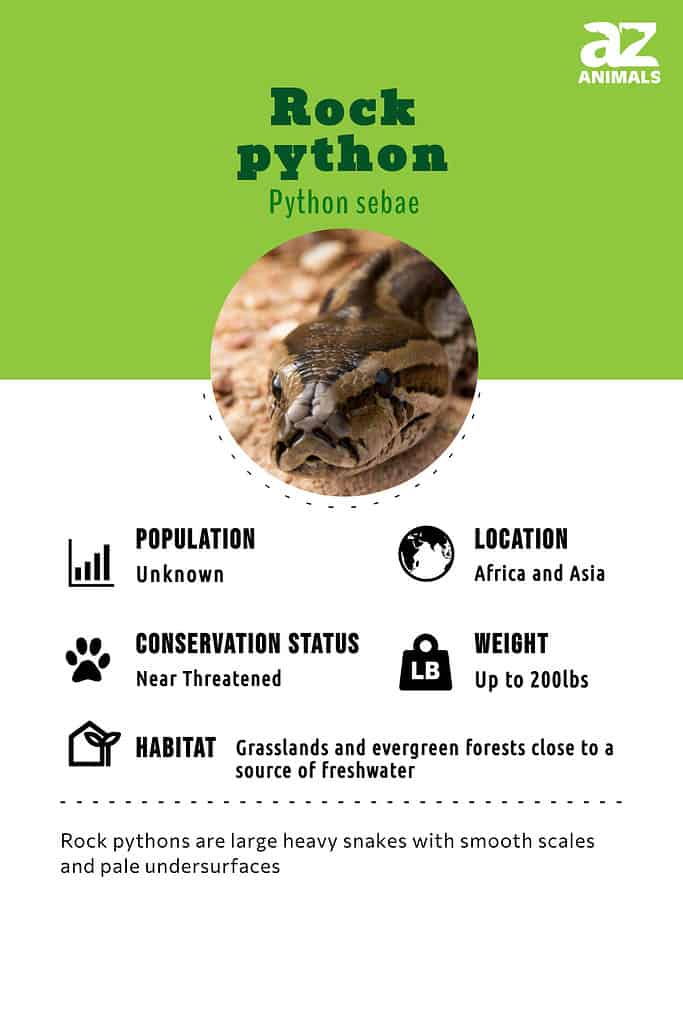
Where To Find Rock Pythons
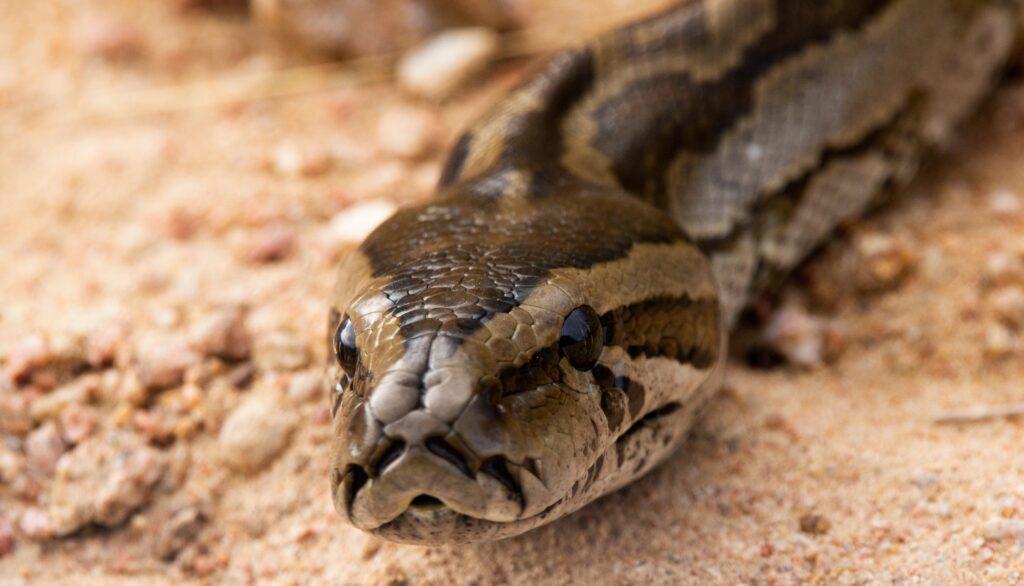
Rock Pythons prefer open grassland or humid verdant forests close to freshwater
©Bruce Crossey/Shutterstock.com
Rock pythons are found in many locations in sub-Saharan Africa, as long as it is not too dry, as it would be in a desert, or too cold as it would be high on a mountain. Their preferred habitats are open savannas and moist evergreen forests near bodies of freshwater, and they get their name because they are often found on outcroppings.
Scientific Name
The African rock python’s scientific name is Python sebae. Python is taken from the Greek nake for the serpent-like monster killed by the god Apollo. Sebae comes from Albertus Seba, a Dutch zoologist. There are two subspecies of P. sebae. They are the following:
- P. subae subae
- P. subae natalensis
The Different Types of Rock Python
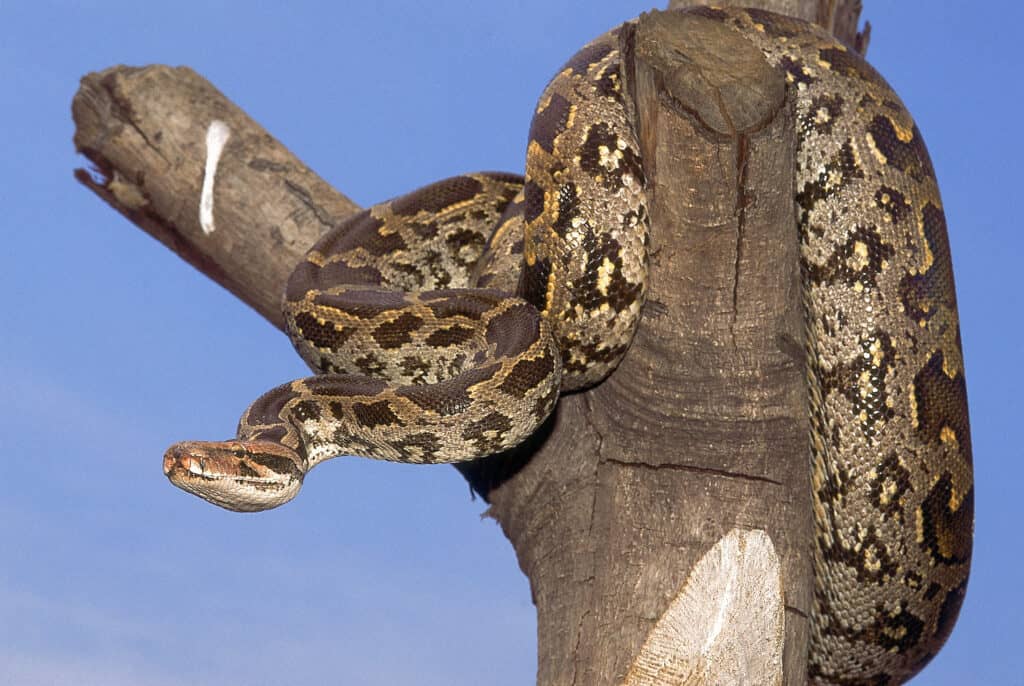
Indian Rock pythons are smaller than their African counterparts and are elusive by nature
©iStock.com/ephotocorp
The two African rock python subspecies are the northern African rock python, P. sebae sebae which is found in western and central Africa, and the southern African rock python which is found in scattered locations around southern Africa, from Namibia to the coasts of Tanzania and Mozambique. The southern python is the smaller and less colorful of the two.
The African rock python and its subspecies aren’t the only types of these snakes. Python molurus is also known as the Indian or Asian rock python. It is smaller in size than the African rock python and lives in India, Pakistan, Bhutan, Bangladesh, and southern Nepal, and some believe there are pythons in Myanmar. The Indian rock python also differs from the African rock python in that it is timid.
Evolution
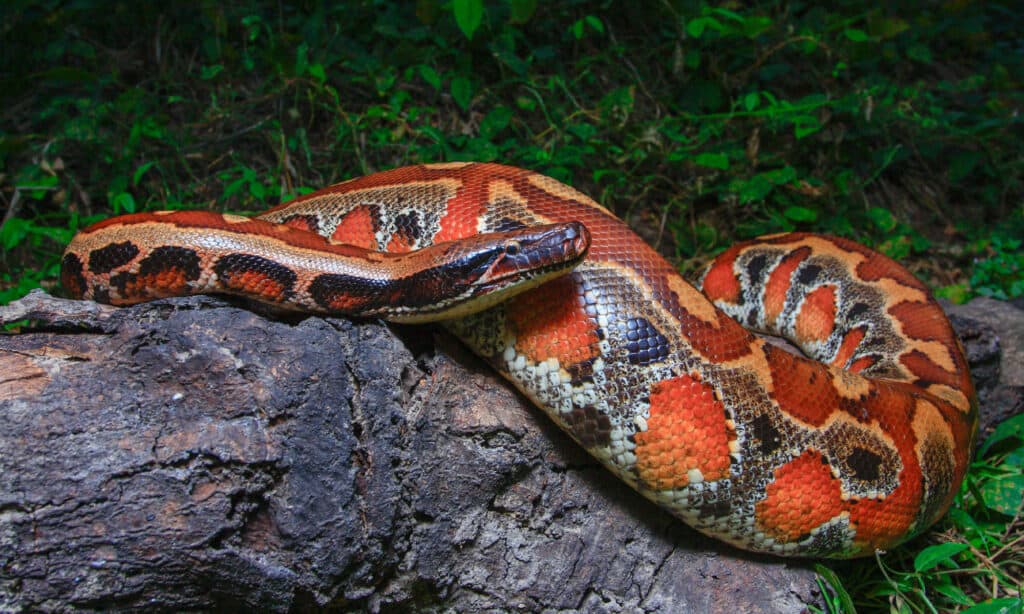
Blood pythons as well as species such as Indian, Burmese, and Angolan pythons are some of the rock python’s closest relatives
©dwi putra stock/Shutterstock.com
Rock pythons are considered true pythons and are members of the genus Python, a distinction they share with 10 other species. Their closest relatives include the Angolan python, the ball python, the blood python, the Borneo python, the Burmese python, the Indian python, the Myanmar short-tailed python, and the Sumatran short-tailed python.
They also belong to the wider Pythonidae family which itself consists of 10 general including:
- Water pythons: Known as the genus Liasis, these snakes can be found in Indonesia, New Guinea, and Australia.
- Tree pythons: Also referred to as the genus Morelia, they can be found in Australia, Indonesia, and New Guinea.
- White-lipped pythons: Members of the Leiopython genus, they can be found in Papua New Guinea.
Population and Conservation Status
Though the number of wild African rock pythons hasn’t been evaluated, the reptile’s conservation status is near threatened. This is largely due to poaching for its meat and its hide. The snake is also under some pressure from habitat loss.
Appearance and Description
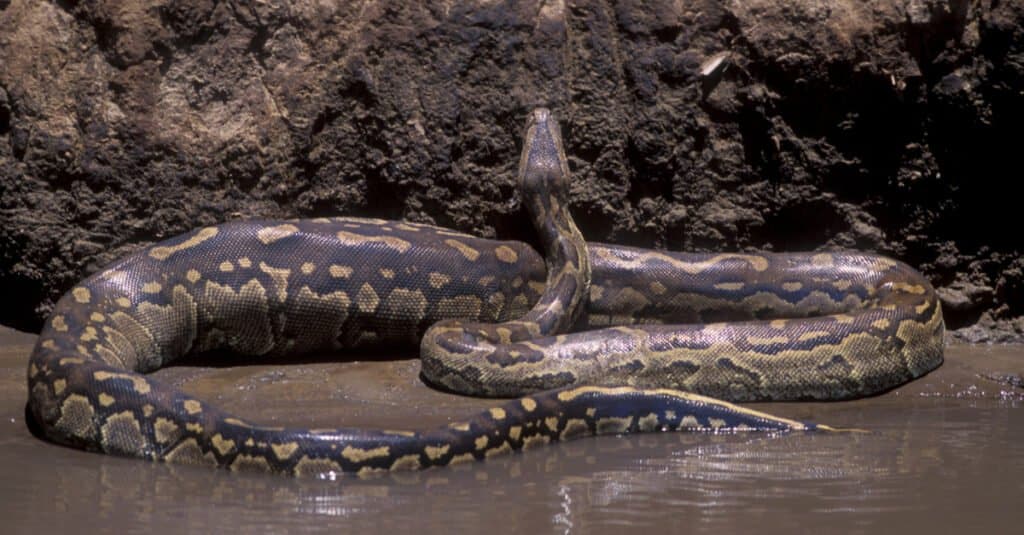
©zaferkizilkaya/Shutterstock.com
An adult P. sebae is a huge animal, ranging from nearly 10 feet to over 20 feet in length, and females are bigger than males. It is not just long but has a robust body that can contribute to it weighing close to 200 pounds or more. It has a small, v-shaped head with a spearhead-shaped pattern on top. The body is grayish-brown, grayish-green, or yellowish with darker blotches edged in white, and the scales are smooth. The belly of the snake is white and speckled with black.
These beautiful patterns and colors make the snake vulnerable to hunters who want its hide for leather. On closer examination, a person might discover pelvic spurs. These are what is left of the hind legs snakes got rid of eons ago. The presence of pelvic spurs is another aid in the identification of a python.
Rock Python vs Burmese Python
Differentiating the rock and Burmese pythons can be challenging because they do look somewhat alike. One means of identification of the Burmese python is that its hide is made of brown blotches edged in black. The blotches on the rock python are edged in white and are sometimes not as distinct and merge together more than the blotches of the other python. The Burmese python, P. bivittatus is also smaller in size than P. sebae and rarely gets over 18 feet long. Though it is considered bad-tempered, the Burmese python is still not as aggressive as the rock python. Though both python mothers incubate and guard their eggs, the Burmese python “shivers” to produce heat for her eggs, while the rock python doesn’t
Venom: How Dangerous Are They?
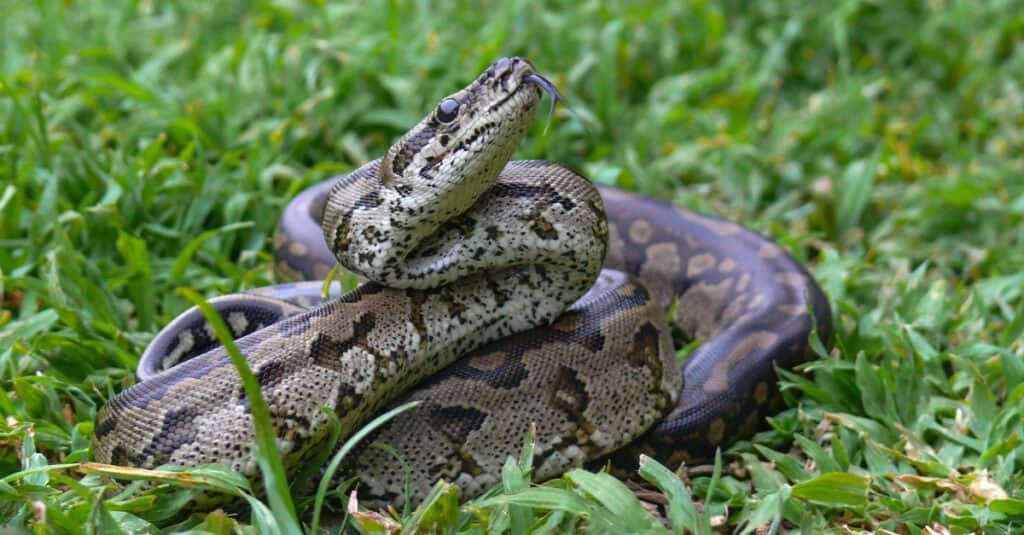
©Chris Graf/Shutterstock.com
These snakes are nonvenomous, but they can grow to be so big and powerful that it’s not safe for an inexperienced person to be around them. Even experienced people are sometimes attacked.
Behavior and Humans
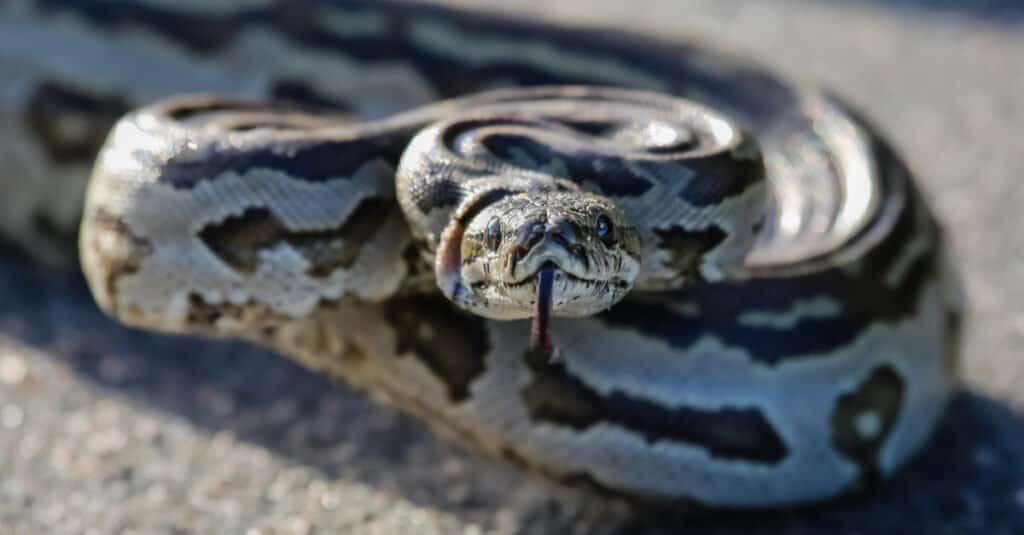
Rock pythons are hunted for their skins and may also be kept as pets by reptile enthusiasts
©Uwe Bergwitz/Shutterstock.com
As with most types of snakes, P. subae is solitary save for the mating season. Despite their great size, they can climb trees well. They’re also good swimmers and sometimes have fish as part of their diet. They are mostly nocturnal predators, though they might bask in the sun to warm up during the day. Younger snakes are more active at sunup and just after sundown and seek shelter in a tree cavity or under a rock outcropping.
These snakes are ready to breed when they’re between three and five years old, which is when females are about 8.86 feet long, and males are about 5.9 feet long. They have a lifespan as long as 30 years in captivity.
The snakes mate in the late fall to late winter or early spring. Both males and females stop eating at this time, and the female won’t eat again until her eggs hatch. She’ll lay them about three months after mating in an abandoned burrow, a cave, a hollow tree, or a termite mound. A clutch can contain from 20 to as many as 100 surprisingly large, hard-shelled eggs. She’ll guard them until they hatch, which is 65 to 80 days after they were laid. Hatchlings are independent at birth. Some mothers take no more care of their babies, while others guard them for as long as two weeks. This is very unusual behavior for a snake.
Though big rock pythons are capable of killing humans, this is very rare. Humans, however, frequently kill rock pythons for their meat and their hides. Some people try to keep these animals as pets. Juvenile pythons are beneficial for they eat rats and other pests before they move on to larger fare as they grow.
Similar Animals
View all 114 animals that start with RRock Python FAQs (Frequently Asked Questions)
Are rock pythons venomous?
Rock pythons are not venomous, but that doesn’t mean they’re not dangerous. They are aggressive predators and strike out when they feel threatened. They have large, curved teeth that deliver painful bites that can become infected, and their coils can suffocate or cut off blood circulation.
How do rock pythons hunt?
Like all snakes, the python has a Jacobson’s organ that allows it to pick up chemical signals produced by potential prey. They also have pits along their mouth that can detect heat given off by warm-blooded animals. Once the prey is detected, the reptile follows it or waits for it to come within range. Then, it will strike, grab the animal with its teeth and wrap its coils around it. Pythons don’t crush their prey but suffocate it until it dies from heart failure. Then, the python swallows it whole.
Are rock pythons aggressive?
Rock pythons are famous for being aggressive. Despite this, it is rare for one to kill a human.
Where do rock pythons live?
Rock pythons live in the savannas and forests of sub-Saharan Africa.
What do rock pythons eat?
A snake as big and powerful as a rock python has a variety of prey as its diet. Juveniles eat rats and other small-sized animals. Adults eat everything from antelopes, to monkeys to crocodiles to livestock. As they are cold-blooded, these snakes don’t need to eat as regularly as most mammals do, and at least one snake went over two years between meals.
What is a rock python?
A rock python, Python subae, is a very large snake that lives in various locations and warm, moist habitats around Africa. It is not venomous but kills its prey through constriction.
How big of animals can rock pythons eat?
The largest animal ever eaten by a rock python was a 150-pound hyena. The incident was recorded in 2017. Previously, the largest record of a rock python meal was a 130-pound impala.
Are rock pythons good pets?
Rock pythons do not make good pets. They grow much too large, can deliver a nasty bite, and to care for them properly is expensive. If they escape or are released into the wild, they can do damage to the ecosystem as an invasive species.
Do rock pythons eat lions?
Rock pythons have been known to eat lion cubs. However, this is rare because the cubs are usually protected by the adults in the pride.
Can rock pythons swim?
They are good swimmers and can even stay underwater for a surprisingly long time.
Can a rock python eat a human?
Smaller humans have, once in a great while, been eaten by these snakes. This is one reason why P. sebae shouldn’t be kept as a pet.
What are the differences between rock python and Burmese python?
The greatest differences between a rock python and a Burmese python are their size and distribution.
Thank you for reading! Have some feedback for us? Contact the AZ Animals editorial team.
Sources
- Wikipedia, Available here: https://en.wikipedia.org/wiki/African_rock_python
- ITIS, Available here: https://www.itis.gov/servlet/SingleRpt/SingleRpt?search_topic=TSN&search_value=634785#null
- Florida Museum, Available here: https://www.itis.gov/servlet/SingleRpt/SingleRpt?search_topic=TSN&search_value=634785#null
- Lincoln Park Zoo, Available here: https://www.lpzoo.org/animal/african-rock-python/
- Toronto Star, Available here: https://www.thestar.com/news/world/2015/10/07/kentucky-reptile-store-owner-recovering-after-python-attack.html
- National Geographic, Available here: https://www.nationalgeographic.com/animals/article/130806-african-rock-python-snakes-canada-killed-boys-world

















